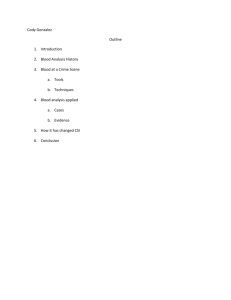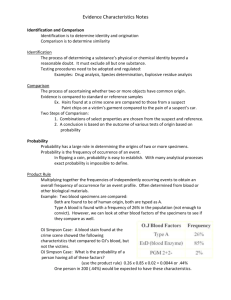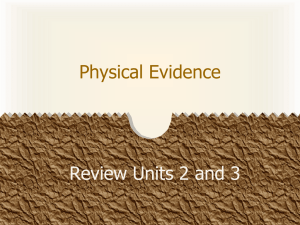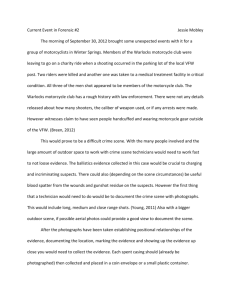BIO 150 Study Guide to accompany Forensic Biology by Richard Li
advertisement
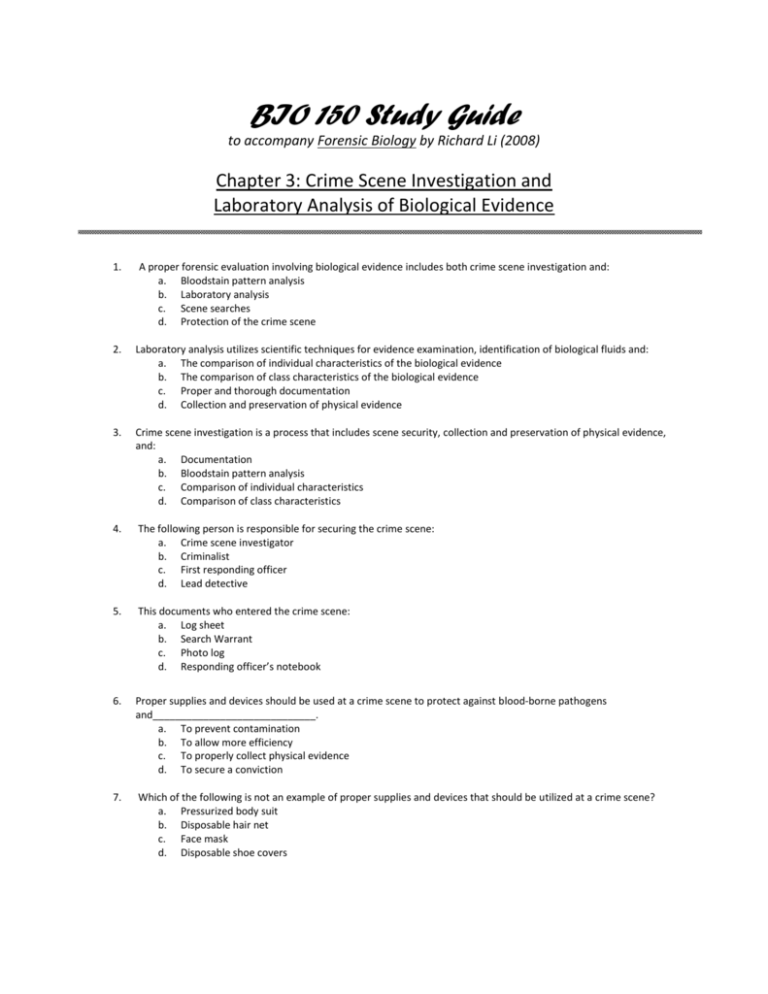
BIO 150 Study Guide to accompany Forensic Biology by Richard Li (2008) Chapter 3: Crime Scene Investigation and Laboratory Analysis of Biological Evidence 1. A proper forensic evaluation involving biological evidence includes both crime scene investigation and: a. Bloodstain pattern analysis b. Laboratory analysis c. Scene searches d. Protection of the crime scene 2. Laboratory analysis utilizes scientific techniques for evidence examination, identification of biological fluids and: a. The comparison of individual characteristics of the biological evidence b. The comparison of class characteristics of the biological evidence c. Proper and thorough documentation d. Collection and preservation of physical evidence 3. Crime scene investigation is a process that includes scene security, collection and preservation of physical evidence, and: a. Documentation b. Bloodstain pattern analysis c. Comparison of individual characteristics d. Comparison of class characteristics 4. The following person is responsible for securing the crime scene: a. Crime scene investigator b. Criminalist c. First responding officer d. Lead detective 5. This documents who entered the crime scene: a. Log sheet b. Search Warrant c. Photo log d. Responding officer’s notebook 6. Proper supplies and devices should be used at a crime scene to protect against blood-borne pathogens and_____________________________. a. To prevent contamination b. To allow more efficiency c. To properly collect physical evidence d. To secure a conviction 7. Which of the following is not an example of proper supplies and devices that should be utilized at a crime scene? a. Pressurized body suit b. Disposable hair net c. Face mask d. Disposable shoe covers 8. Proper photographs of bloodstains should include: a. A scale b. A photo log c. Lighting conditions d. All of the above 9. The two types of sketches commonly made of crime scenes are: a. Computer generated and rough b. Overall and General c. Exploded and Overall d. Rough and Finished 10. Crime Scene Tech Smith collects a swab of a suspected bloodstain and turns it over to Detective Jones. This transfer would be documented in: a. The chain of custody b. The search warrant c. The search warrant inventory d. The evidence log 11. Corpus Delicti evidence refers to: a. Evidence that links the suspect to the scene b. Evidence that links the suspect to the victim c. Evidence that demonstrates a crime has occurred d. Evidence that links cases to other similar cases 12. This principle states that cross transference occurs when a perpetrator has any physical contact with something or someone else: a. Locard exchange principle b. Bertillion exchange principle c. Cross-Transference principle d. Victim-to-scene linkage principle 13. Blood found at a crime scene is analyzed at a laboratory and a DNA profile is obtained identifying the suspect. This is an example of: a. Perpetrator-to-scene linkage b. Case-to-case linkage c. Modus operandi linkage d. Corpus delicti linkage 14. Modus operandi refers to: a. The class characteristics of evidence b. The individual characteristics of evidence c. The victim-to-scene linkage d. The pattern of behavior of some criminals 15. An example of case-to-case linkage would be: a. A hair similar to the suspect’s found on the victim b. Semen from the same male found at three separate rape scenes c. One fingerprint at the point of entry of a burglary d. Several semen stains at a scene 16. Non-destructive analysis should be carried out first: a. When multiple analyses are needed b. When bloodstains are present c. When control samples are taken d. With wet evidence 17. Which of the following should be air dried prior to packaging? a. A wet bloodstained shirt b. A swab of liquid blood c. A drop of liquid blood on FTA Paper d. All of the above 18. Heat and _______ should be avoided in order to protect biological evidence. a. Cold b. Humidity c. Aridity d. Cross-contamination 19. Two shirts with dried bloodstains are collected from different areas of the same crime scene. The proper collection method is: a. Bagging them together in order to preserve trace evidence b. Letting them air dry and bagging together c. Bagging them separately d. Folding them in a bag together 20. Which of the following would be used for collecting hairs? a. Lifting method b. Alternate Light Source c. Luminol d. FTA Paper 21. Which of the following should be used for collecting a condom? a. FTA Paper b. Collect entire condom c. Drain fluid into a plastic bag and seal tightly d. Lifting method 22. The method for collecting dried bloodstains that works best with non-absorbent surfaces is the a. Cutting method b. Lifting method c. Swab method d. Scraping method 23. The analytical activities of forensic biologists can be categorized into: a. The identification of biological evidence and the comparison of individual characteristics b. The identification of linkage characteristics and individual characteristics c. Reporting and testifying d. None of the abov 24. This is defined as characteristics that the evidence possesses that share a common origin with a reference sample with a high degree of certainty: a. Class characteristics b. Modus operandi c. Linkage analysis d. Individual characteristics 25. Reconstruction of the crime is usually performed in cases involving: a. Trace evidence b. DNA c. Blood spatter patterns d. Individual characteristic evidence



